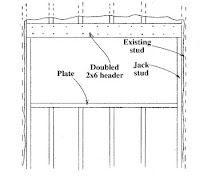 |
| header construction |
You gotta love the "courage" of some of the folks we run across while looking for DotD nominees. We have no idea whether they're competent in the fields where they're trained, but it takes a special level of gall to pound out some of the stuff we see. Today, we're featuring a repeat offender from WiseGEEK.com, Malcolm Tatum, who pretended that he knew enough about framing and construction to tell his readers, "What is a Window Header?" (now at niche site InfoBloom.com). We're here to tell you he didn't know that much, which is why he got a lot of it wrong.
Before we look at what Tatum tried to say, we'll fill you in on what a window header actually is: Any header is a framing component that supports the load of the roof and any upper stories where there is an opening – i.e., door or window – in a stick-framed wall. Headers are generally constructed of a "sandwich" of wide dimensional lumber set on edge and supported at the ends by short studs called jack studs. See the image above...
That is, of course, not what Malcolm tried to tell people. No, in the same way that he managed to botch his discussions of joist spacing and drywall repair, Tatum took some useful information and added it to his own ignorance of his topic, which is where he came up with misinformation such as,
- "With a window header, the window frame will not have to bear any load after window installation." – While nominally true, that's not why an opening for a window has a header.
- "Window headers are supports found on the upper portion of the window casing." – No, they're found above the rough opening, not "on the upper portion of" the molding around a window.
- "Generally, the supports are at least twice as thick as the framing components found around the opening." – The stupidity of that "Generally" not withstanding, the width (not thickness) of a header must be calculated based on opening size, load, and other "considerations" (as eHowians would say).
- "A traditional window header will be located near two joists, rafters, or studs, depending on how the windows are placed." – "Near"? WTF, Mal?!
- "the window header also helps the overall structure to support and distribute the weight of the roof across the interior supporting walls as well as the exterior walls." – Uhhh, Malcolm? the idea is to transmit the load of the structure to the foundation; not the walls.
- "It is not unusual for a window header to be replaced during part of a home improvement renovation." – Says who? Only if the renovation entails a larger opening, Mal.
- "This is especially true when new window casings are inserted as part of the renovation project." – What's Tatum's fascination with casings, anyway?
Tatum never managed to spit out any useful information about framing a header; not mentioning the king, jack, and cripple studs or giving any insight into how a header is constructed. We think all his errors and his omissions are a perfect reason to give Tatum the Dumbass of the Day award – his eighth trip to the stage. Go, Mal, go! and don't come back...
DDIY - FRAMING
No comments:
Post a Comment